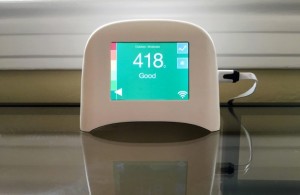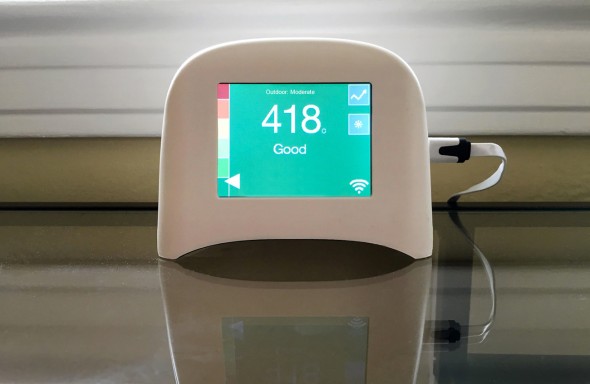
How Dirty Is Your Air?
I didn’t know it, but the eggs my boys were cooking for themselves each morning were putting me at risk of premature death.
The danger wasn’t the eggs per se, but tiny cooking oil particulates that the stove’s heat was launching into the air. These particulates, known as PM2.5 because of their 2.5-micron size, have been linked with asthma (which I have), heart disease, stroke, and even autism and Attention Deficit Hyperactivity Disorder (ADHD) in children born to mothers exposed during pregnancy. The World Health Organization estimates that 80 percent of people living in urban environments are being exposed to unhealthy levels of air pollution from particulates and it says they cause four million deaths annually around the world.
Most of those deaths come from poorly ventilated indoor cooking and heating fires. But in my Arlington, Virginia, townhouse, the PM2.5 level was spiking to unhealthy levels whenever we sautéed something in oil on the electric stove.
Air particulates are invisible, but a new generation of indoor air monitors makes it easy to know the air quality instantaneously and take immediate corrective action. In my family’s case, we learned that turning on the exhaust fan helps—it lowers the PM2.5 from 250 to 100 micrograms per cubic meter, but getting the number below 50 required opening windows in the front and back of the house to get cross ventilation. Of course, opening the window only works if the outdoor air is cleaner than the indoor air—something that’s usually the case, but not always.
 The Speck 2.0 air quality sensor costs $200.
The Speck 2.0 air quality sensor costs $200.
My family’s sudden awareness of air quality is thanks to a Speck 2.0 instrument that we purchased in March. The $200 device has a tiny air sensor, a nearly silent fan, and a touch-sensitive screen that displays the current PM2.5 level. There is a color graph indicating if the room is in the danger level, and a historical display. The device also has a Wi-Fi connection, allowing you to archive your air readings over time on the Internet and display other information, like the current outside air quality.
The instrument is made by Airviz Inc., a two-year-old Carnegie Mellon University spinoff. Although there are other air-quality monitors on the market, the Speck stands out. Because it has a screen, it’s easy to check both the current and recent air quality. Because it has Wi-Fi, the data are constantly uploaded to the company’s website. You can keep your measurements private, or make your anonymous data publicly available. Airviz uses these public sensors to power citizen science efforts, such as a map showing indoor and outdoor air quality around the world, as measured by their instruments.
Airviz also has a cell-phone app that lets you display the air quality of any of your sensors as well as the outdoor air quality from official data sources.
In the coming year, low-cost, networked air-quality sensors such as the Speck may fundamentally change our understanding of both indoor and outdoor air quality. We will be able to find and control air pollution emitters like never before, no matter if the emitter is a neighbor with a dirty diesel engine, an electroplating shop, or—in my case—a stove with an underpowered exhaust hood. And by combining knowledge of indoor and outdoor air quality, we’ll be able to take actions to immediately improve the situation.
“For asthma, indoor air quality is incredibly important to measure because that’s the quantum of control we have: we can make our houses cleaner—much cleaner—if we understand,” says AirViz president Illah Nourbakhsh.
Another surprise discovery for my family was just how much the outdoor air quality changes day to day. When we installed it, our sensor was routinely reporting PM2.5 of under 1. Then came the fires in the Shenandoah National Park in late April, and we saw the indoor levels steadily increase from 1 to 10.
The Speck also records and archives temperature and humidity. Although there are other sensors on the market that measure levels of volatile organic compounds (VOC), carbon monoxide, and oxygen, Nourbakhsh says that the VOC sensors that her company has tested degrade significantly over time, and most houses already have carbon monoxide sensors.
After living with one of these monitors for two months, it’s clear that there is no substitute for measuring air quality—and measuring it constantly. It’s made the whole family aware of just how much our activities influence the air. Blow out a candle, and the particulate count spikes: it’s far cleaner to snuff the burning flame with a wet fingertip. Some clean-air lovers have taken the drastic measure of banning candles from their homes entirely.
Of course, the real particulate danger comes from ongoing, continuous exposure. As a result, we’re now much more conscious of the need to turn on the vent when cooking—and to open the windows when it’s clean outside.

Leave a Reply